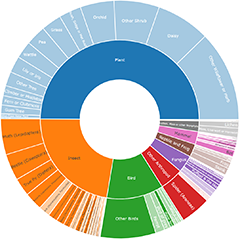Beetles (Coleoptera)
Announcements
There are currently no announcements.
Discussion
Pirom
wrote:
Yesterday
The orange colour and uninterrupted dark midline perhaps suggest R. lineata? https://bie.ala.org.au/species/https://biodiversity.org.au/afd/taxa/6fa656c8-9370-4e97-9725-8cd480e37694#gallery
Rhinotia adelaidae
MarkH
wrote:
Yesterday
Difficult to determine however the pattern is similar to superba from northern NSW. It would be great if the specimen was retained and lodged with ANIC
Melobasis sp. (genus)
HaukeKoch
wrote:
11 Dec 2025
Wow, just found this. It looks like you caught an undescribed pyrgotid fly in the act of approaching Neorrhina punctatum. This appears to be the same fly I have reared from this host: (https://www.inaturalist.org/observations/253727914) and is to my knowledge the first picture showing the fly in the wild and together with its host.
Neorrhina punctatum
Significant sightings
- Scolecobrotus variegatus at Reid, ACT
- Mordellistena (genus) at Campbell, ACT
- Paropsis pantherina at Broke, NSW
- Australoneda bourgeoisi at Nimbin, NSW
- Aporocera rufescens at Rendezvous Creek, ACT
- Araiorrhinus howittii at Melba, ACT
- Atesta chiangi at Melba, ACT
- Chlorobapta bestii at Oallen, NSW
- Paraschizognathus elgatus at Falls Creek, VIC
- Temognatha thoracica at Cook, ACT
Top contributors
- AlisonMilton 3K
- Hejor1 2.2K
- Harrisi 2K
- kasiaaus 1.1K
- trevorpreston 1.1K
- ConBoekel 850
- clarehoneydove 790
- CathB 615
- jb2602 554
- HelenCross 498
Top moderators
- AlisonMilton 9.1K
- MichaelMulvaney 5K
- KimberiRP 2.7K
- KimPullen 2.2K
- MichaelBedingfield 1K
- Harrisi 931
- Amata 846
- DiBickers 484
- MarkH 295
- HaukeKoch 266














































































































